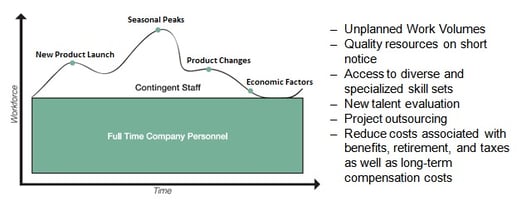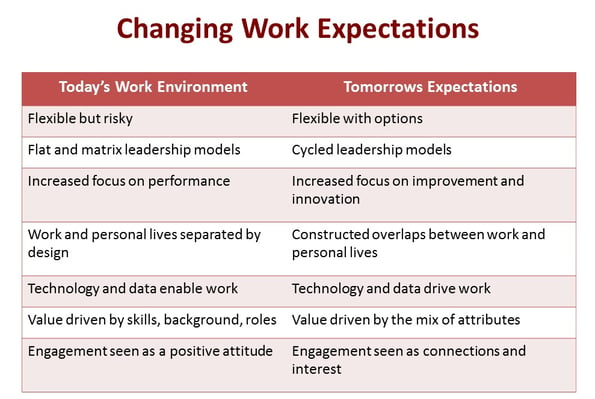Published on
How iLearn! How iWork! - Adapting to a Changing Workforce World Part 1
[caption id="attachment_4959" align="alignnone" width="600" caption="The modern workplace is more multi-dimensional than ever before, as employers are forming cross-functional teams of full time, part time, temporary and contract workers depending on what is needed to meet business goals. Image by Hiro Sheridan."]
 [/caption]
Why didn’t we see this coming? The Blended Workforce has been growing for years, mainly from outsourcing repeatable human tasks; janitorial service, lawn care, trash disposal, etc. These repeatable tasks are not core to your business success, unless of course you own a fast food franchise. Those repeatable tasks have provided many “outsourced” part time jobs for students and households working two jobs, and still do. We don’t think of these jobs as outsourcing or off-shoring . We are happy someone does those jobs. Outsourcing doesn’t necessarily mean shipping jobs out of the U.S. These were alternatives to full-time employees at lower costs and, in the majority of instances, work was performed better and more efficiently allowing employers to hire much needed value workers with science, computational math, information technology and critical path skills. Audit firms with access to clients’ books could find more ways to “outsource” work to lower cost of labor and provide specialized skills on-demand to meet the changes required to remain competitive. Thus began the era of off-shoring. Big consulting firms like KPMG, PricewaterhouseCoopers, Ernst & Young, KPMG, Accenture, etc., were contracted for more complex and longer term projects, like deployment of ERP systems where a cohort of technical talent was required. Those same technologies further reduced repetitive and time-consuming tasks to automated processes; like payroll. These events gradually eliminated many entry level jobs for those with the desire, but not the education or skills. While in other parts of the world, outsourcing as a contingent workforce or group of specialized skill workers has been perfected over time. Why? Mostly due a lack of graduates with Science, Technology, Engineering or Math (STEM) skills. The other reason is many more labor work rules and government regulations allowing very little flexibity for adjusting the workforce size and lead to less rapid responses to market changes and competition. More recently, according to research from Staffing Industry Analysts, statement of work (SOW) spending inside contingent workforce programs has been increasing significantly, leading some to wonder if this is because traditional temporary worker spend is shifting to higher skilled levels SOW spend due to the increasing shortage of STEM educated workers. Also foreign students coming to the U.S. to obtain their college degrees—who used to stay on with a work visa to utilize their STEM skills—are more often now returning to their homeland. Many companies define these categories very differently and the lines get crossed frequently. Some categorize temps as such based on how their vendor is categorized in their accounts payable system—they come from companies on a specified list and cannot cross over to an SOW list. Others, meanwhile, categorize temporary workers based on the method by which they are engaged and billed. Hourly workers equal temps while fixed billings or milestone billings equate to SOW. Today between 40% and 50% of total labor costs of an organization is not done by full-time employees on payroll getting a W-2. Another 20% are the contracted services. The balance of the total workforce is a variable depending on the needs of the organization for talent to meet ever changing (get used to it if you are not yet adjusted to constant change in the workplace) business decisions regarding markets, products, distribution, competition and so on.
[/caption]
Why didn’t we see this coming? The Blended Workforce has been growing for years, mainly from outsourcing repeatable human tasks; janitorial service, lawn care, trash disposal, etc. These repeatable tasks are not core to your business success, unless of course you own a fast food franchise. Those repeatable tasks have provided many “outsourced” part time jobs for students and households working two jobs, and still do. We don’t think of these jobs as outsourcing or off-shoring . We are happy someone does those jobs. Outsourcing doesn’t necessarily mean shipping jobs out of the U.S. These were alternatives to full-time employees at lower costs and, in the majority of instances, work was performed better and more efficiently allowing employers to hire much needed value workers with science, computational math, information technology and critical path skills. Audit firms with access to clients’ books could find more ways to “outsource” work to lower cost of labor and provide specialized skills on-demand to meet the changes required to remain competitive. Thus began the era of off-shoring. Big consulting firms like KPMG, PricewaterhouseCoopers, Ernst & Young, KPMG, Accenture, etc., were contracted for more complex and longer term projects, like deployment of ERP systems where a cohort of technical talent was required. Those same technologies further reduced repetitive and time-consuming tasks to automated processes; like payroll. These events gradually eliminated many entry level jobs for those with the desire, but not the education or skills. While in other parts of the world, outsourcing as a contingent workforce or group of specialized skill workers has been perfected over time. Why? Mostly due a lack of graduates with Science, Technology, Engineering or Math (STEM) skills. The other reason is many more labor work rules and government regulations allowing very little flexibity for adjusting the workforce size and lead to less rapid responses to market changes and competition. More recently, according to research from Staffing Industry Analysts, statement of work (SOW) spending inside contingent workforce programs has been increasing significantly, leading some to wonder if this is because traditional temporary worker spend is shifting to higher skilled levels SOW spend due to the increasing shortage of STEM educated workers. Also foreign students coming to the U.S. to obtain their college degrees—who used to stay on with a work visa to utilize their STEM skills—are more often now returning to their homeland. Many companies define these categories very differently and the lines get crossed frequently. Some categorize temps as such based on how their vendor is categorized in their accounts payable system—they come from companies on a specified list and cannot cross over to an SOW list. Others, meanwhile, categorize temporary workers based on the method by which they are engaged and billed. Hourly workers equal temps while fixed billings or milestone billings equate to SOW. Today between 40% and 50% of total labor costs of an organization is not done by full-time employees on payroll getting a W-2. Another 20% are the contracted services. The balance of the total workforce is a variable depending on the needs of the organization for talent to meet ever changing (get used to it if you are not yet adjusted to constant change in the workplace) business decisions regarding markets, products, distribution, competition and so on.
 The facts are that agile enterprises will need to be flexible in order to respond more quickly to the challenges ahead. They will need that specialized talent temporarily as the cycles of market, products and competition shift at different speeds over time. There is a growing supply of specialized talent that organizations won’t hire as full time employees and then have to terminate them when the activity, scope of work, or project is completed for that cycle. Therefore, there will be a need to continuously add and delete temporary specialized talent. CxOs will need to eliminate silos in their organization, form cross functional teams of full time, part-time, temp and contract worker based on the talent drivers needed to meet business goals. They will also need better or improved management tools to gain real-time visibility into the full labor force costs, risk, talent opportunities needs and forecasting.
The facts are that agile enterprises will need to be flexible in order to respond more quickly to the challenges ahead. They will need that specialized talent temporarily as the cycles of market, products and competition shift at different speeds over time. There is a growing supply of specialized talent that organizations won’t hire as full time employees and then have to terminate them when the activity, scope of work, or project is completed for that cycle. Therefore, there will be a need to continuously add and delete temporary specialized talent. CxOs will need to eliminate silos in their organization, form cross functional teams of full time, part-time, temp and contract worker based on the talent drivers needed to meet business goals. They will also need better or improved management tools to gain real-time visibility into the full labor force costs, risk, talent opportunities needs and forecasting.
 Tomorrow as described in the chart above has already arrived. Get used to it. Better yet, understand it. Once you understand how we got here, you can more easily sort out where you can fit and what additional education, coursework or skills from a trade school you will need to catch up and stay current with your newly adapted skills.
Please return on Friday for Part 2, where I discuss connecting lifelong learning in a virtual workforce.
Tomorrow as described in the chart above has already arrived. Get used to it. Better yet, understand it. Once you understand how we got here, you can more easily sort out where you can fit and what additional education, coursework or skills from a trade school you will need to catch up and stay current with your newly adapted skills.
Please return on Friday for Part 2, where I discuss connecting lifelong learning in a virtual workforce.
 [/caption]
Why didn’t we see this coming? The Blended Workforce has been growing for years, mainly from outsourcing repeatable human tasks; janitorial service, lawn care, trash disposal, etc. These repeatable tasks are not core to your business success, unless of course you own a fast food franchise. Those repeatable tasks have provided many “outsourced” part time jobs for students and households working two jobs, and still do. We don’t think of these jobs as outsourcing or off-shoring . We are happy someone does those jobs. Outsourcing doesn’t necessarily mean shipping jobs out of the U.S. These were alternatives to full-time employees at lower costs and, in the majority of instances, work was performed better and more efficiently allowing employers to hire much needed value workers with science, computational math, information technology and critical path skills. Audit firms with access to clients’ books could find more ways to “outsource” work to lower cost of labor and provide specialized skills on-demand to meet the changes required to remain competitive. Thus began the era of off-shoring. Big consulting firms like KPMG, PricewaterhouseCoopers, Ernst & Young, KPMG, Accenture, etc., were contracted for more complex and longer term projects, like deployment of ERP systems where a cohort of technical talent was required. Those same technologies further reduced repetitive and time-consuming tasks to automated processes; like payroll. These events gradually eliminated many entry level jobs for those with the desire, but not the education or skills. While in other parts of the world, outsourcing as a contingent workforce or group of specialized skill workers has been perfected over time. Why? Mostly due a lack of graduates with Science, Technology, Engineering or Math (STEM) skills. The other reason is many more labor work rules and government regulations allowing very little flexibity for adjusting the workforce size and lead to less rapid responses to market changes and competition. More recently, according to research from Staffing Industry Analysts, statement of work (SOW) spending inside contingent workforce programs has been increasing significantly, leading some to wonder if this is because traditional temporary worker spend is shifting to higher skilled levels SOW spend due to the increasing shortage of STEM educated workers. Also foreign students coming to the U.S. to obtain their college degrees—who used to stay on with a work visa to utilize their STEM skills—are more often now returning to their homeland. Many companies define these categories very differently and the lines get crossed frequently. Some categorize temps as such based on how their vendor is categorized in their accounts payable system—they come from companies on a specified list and cannot cross over to an SOW list. Others, meanwhile, categorize temporary workers based on the method by which they are engaged and billed. Hourly workers equal temps while fixed billings or milestone billings equate to SOW. Today between 40% and 50% of total labor costs of an organization is not done by full-time employees on payroll getting a W-2. Another 20% are the contracted services. The balance of the total workforce is a variable depending on the needs of the organization for talent to meet ever changing (get used to it if you are not yet adjusted to constant change in the workplace) business decisions regarding markets, products, distribution, competition and so on.
[/caption]
Why didn’t we see this coming? The Blended Workforce has been growing for years, mainly from outsourcing repeatable human tasks; janitorial service, lawn care, trash disposal, etc. These repeatable tasks are not core to your business success, unless of course you own a fast food franchise. Those repeatable tasks have provided many “outsourced” part time jobs for students and households working two jobs, and still do. We don’t think of these jobs as outsourcing or off-shoring . We are happy someone does those jobs. Outsourcing doesn’t necessarily mean shipping jobs out of the U.S. These were alternatives to full-time employees at lower costs and, in the majority of instances, work was performed better and more efficiently allowing employers to hire much needed value workers with science, computational math, information technology and critical path skills. Audit firms with access to clients’ books could find more ways to “outsource” work to lower cost of labor and provide specialized skills on-demand to meet the changes required to remain competitive. Thus began the era of off-shoring. Big consulting firms like KPMG, PricewaterhouseCoopers, Ernst & Young, KPMG, Accenture, etc., were contracted for more complex and longer term projects, like deployment of ERP systems where a cohort of technical talent was required. Those same technologies further reduced repetitive and time-consuming tasks to automated processes; like payroll. These events gradually eliminated many entry level jobs for those with the desire, but not the education or skills. While in other parts of the world, outsourcing as a contingent workforce or group of specialized skill workers has been perfected over time. Why? Mostly due a lack of graduates with Science, Technology, Engineering or Math (STEM) skills. The other reason is many more labor work rules and government regulations allowing very little flexibity for adjusting the workforce size and lead to less rapid responses to market changes and competition. More recently, according to research from Staffing Industry Analysts, statement of work (SOW) spending inside contingent workforce programs has been increasing significantly, leading some to wonder if this is because traditional temporary worker spend is shifting to higher skilled levels SOW spend due to the increasing shortage of STEM educated workers. Also foreign students coming to the U.S. to obtain their college degrees—who used to stay on with a work visa to utilize their STEM skills—are more often now returning to their homeland. Many companies define these categories very differently and the lines get crossed frequently. Some categorize temps as such based on how their vendor is categorized in their accounts payable system—they come from companies on a specified list and cannot cross over to an SOW list. Others, meanwhile, categorize temporary workers based on the method by which they are engaged and billed. Hourly workers equal temps while fixed billings or milestone billings equate to SOW. Today between 40% and 50% of total labor costs of an organization is not done by full-time employees on payroll getting a W-2. Another 20% are the contracted services. The balance of the total workforce is a variable depending on the needs of the organization for talent to meet ever changing (get used to it if you are not yet adjusted to constant change in the workplace) business decisions regarding markets, products, distribution, competition and so on.
 The facts are that agile enterprises will need to be flexible in order to respond more quickly to the challenges ahead. They will need that specialized talent temporarily as the cycles of market, products and competition shift at different speeds over time. There is a growing supply of specialized talent that organizations won’t hire as full time employees and then have to terminate them when the activity, scope of work, or project is completed for that cycle. Therefore, there will be a need to continuously add and delete temporary specialized talent. CxOs will need to eliminate silos in their organization, form cross functional teams of full time, part-time, temp and contract worker based on the talent drivers needed to meet business goals. They will also need better or improved management tools to gain real-time visibility into the full labor force costs, risk, talent opportunities needs and forecasting.
The facts are that agile enterprises will need to be flexible in order to respond more quickly to the challenges ahead. They will need that specialized talent temporarily as the cycles of market, products and competition shift at different speeds over time. There is a growing supply of specialized talent that organizations won’t hire as full time employees and then have to terminate them when the activity, scope of work, or project is completed for that cycle. Therefore, there will be a need to continuously add and delete temporary specialized talent. CxOs will need to eliminate silos in their organization, form cross functional teams of full time, part-time, temp and contract worker based on the talent drivers needed to meet business goals. They will also need better or improved management tools to gain real-time visibility into the full labor force costs, risk, talent opportunities needs and forecasting.
 Tomorrow as described in the chart above has already arrived. Get used to it. Better yet, understand it. Once you understand how we got here, you can more easily sort out where you can fit and what additional education, coursework or skills from a trade school you will need to catch up and stay current with your newly adapted skills.
Please return on Friday for Part 2, where I discuss connecting lifelong learning in a virtual workforce.
Tomorrow as described in the chart above has already arrived. Get used to it. Better yet, understand it. Once you understand how we got here, you can more easily sort out where you can fit and what additional education, coursework or skills from a trade school you will need to catch up and stay current with your newly adapted skills.
Please return on Friday for Part 2, where I discuss connecting lifelong learning in a virtual workforce.
Author Perspective: Business



